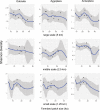Landscape-scale terrestrial factors are also vital in shaping Odonata assemblages of watercourses
- PMID: 31796792
- PMCID: PMC6890666
- DOI: 10.1038/s41598-019-54628-7
Landscape-scale terrestrial factors are also vital in shaping Odonata assemblages of watercourses
Abstract
Habitat loss and fragmentation causes a decline in insect populations. Odonata (both dragonflies and damselflies) are especially threatened by the destruction of both aquatic and terrestrial environment. Moreover, effects of large-scale habitat heterogeneity on Odonata assemblages are poorly studied. In a two years study along East-European lowland watercourses both aquatic and terrestrial environment were studied to reveal the importance of local (e.g. water depth, macrovegetation cover, etc.) and landscape-scale (e.g. farmland patch size, forest patch proportion, etc.) variables to Odonata (as well as to dragonflies and damselflies separately) through increasing spatial sampling scales. The specimens were sampled using 500 m long transects from May to September. Results, both on local and landscape scales emphasized the importance of terrestrial environment on Odonata. Local variables influence damselflies, while dragonflies are more sensitive to landscape variables. Damselfly's diversity decreased with increasing macrovegetation cover, while dragonfly's diversity decreased with the increasing degree of land use intensification, but increased with the length of watercourses. It is thus vital to stress the importance of partial watercourse clearing, and moderate maintenance of traditional farm management based on small parcel farming near watercourses to maintain diverse and healthy Odonata assemblages.
Conflict of interest statement
The authors declare no competing interests.
Figures


References
-
- da Silva Monteiro Júnior C, Couceiro SRM, Hamada N, Juen L. Effect of vegetation removal for road building on richness and composition of Odonata communities in Amazonia, Brazil. Int. J. Odonatol. 2013;16:135–144. doi: 10.1080/13887890.2013.764798. - DOI
-
- Corbet, P. S. Dragonflies: Behaviour and Ecology of Odonata. (Harley Books, Colchester, 1999).
-
- Simaika JP, Samways MJ. Comparative assessment of indices of freshwater habitat conditions using different invertebrate taxon sets. Ecol. Indic. 2011;11:370–378. doi: 10.1016/j.ecolind.2010.06.005. - DOI
-
- Raebel EM, et al. Multi-scale effects of farmland management on dragonfly and damselfly assemblages of farmland ponds. Agric. Ecosyst. Environ. 2012;161:80–87. doi: 10.1016/j.agee.2012.07.015. - DOI
-
- Sahlén, G. Specialists vs. generalists in the Odonata, the importance of forest environments in the formation of diverese species pools. In Forest andDragonflies (ed. Cordero Rivera, A.) 153–180 (Pensoft, 2006).
Publication types
MeSH terms
Substances
LinkOut - more resources
Full Text Sources

